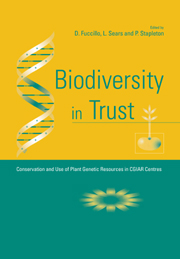Book contents
- Frontmatter
- Contents
- Preface
- Contributors
- Acronyms
- Chapter 1 Cassava
- Chapter 2 The Potato
- Chapter 3 Sweetpotato
- Chapter 4 Other Andean Roots and Tubers
- Chapter 5 Yams
- Chapter 6 Banana and Plantain
- Chapter 7 Cowpea
- Chapter 8 Chickpea
- Chapter 9 Groundnut
- Chapter 10 Lentil
- Chapter 11 Phaseolus Beans
- Chapter 12 Pigeonpea
- Chapter 13 Faba Bean
- Chapter 14 Soyabean
- Chapter 15 Barley
- Chapter 16 Maize, Tripsacum and Teosinte
- Chapter 17 Pearl Millet
- Chapter 18 Small Millets
- Chapter 19 Rice
- Chapter 20 Sorghum
- Chapter 21 Wheat
- Chapter 22 Forages
- Index
Chapter 9 - Groundnut
Published online by Cambridge University Press: 22 September 2009
- Frontmatter
- Contents
- Preface
- Contributors
- Acronyms
- Chapter 1 Cassava
- Chapter 2 The Potato
- Chapter 3 Sweetpotato
- Chapter 4 Other Andean Roots and Tubers
- Chapter 5 Yams
- Chapter 6 Banana and Plantain
- Chapter 7 Cowpea
- Chapter 8 Chickpea
- Chapter 9 Groundnut
- Chapter 10 Lentil
- Chapter 11 Phaseolus Beans
- Chapter 12 Pigeonpea
- Chapter 13 Faba Bean
- Chapter 14 Soyabean
- Chapter 15 Barley
- Chapter 16 Maize, Tripsacum and Teosinte
- Chapter 17 Pearl Millet
- Chapter 18 Small Millets
- Chapter 19 Rice
- Chapter 20 Sorghum
- Chapter 21 Wheat
- Chapter 22 Forages
- Index
Summary
Groundnut, Arachis hypogaea L. (also called peanut in English, mani in Spanish, amondoim in Portuguese, pistache in French, mungphali in Hindi and ying zui dou in Chinese), ranks 13th among food crops and annual oilseed crops (FAO 1995). Its high oil and protein contents serve important needs for food, energy and industrial uses. Although a native of South America, the crop is now cultivated in tropical, subtropical and warm temperate regions of the world extending from 40°N to 40°S.
BOTANY AND DISTRIBUTION
Arachis hypogaea L. is a member of family Leguminoseae-Papilionoideae, tribe Aeschynomeneae and subtribe Stylosanthinae. It is a tetraploid with 2n=40. Krapovickas and Gregory (1994) divided the genus Arachis into nine sections. Section Arachis contains cultivated groundnut, A. hypogaea, another tetraploid species A. monticola Krapov. & Rigoni and a number of wild diploid species. Gregory et al. (1973) earlier divided A. hypogaea into two subspecies, fastigiata Waldron and hypogaea Krap. et Rig., and each subspecies into two botanical varieties. According to the new classification, subsp. fastigiata is subdivided into four botanical varieties, fastigiata, peruviana Krapov. & W.C. Gregory, aequatoriana Krapov. & W.C. Gregory and vulgaris C. Harz. The two botanical varieties in subsp. hypogaea are hypogaea and hirsuta Kohler. The key for identification of different botanical varieties is given in Box 9.1.
Origin, Domestication and Diffusion
The genus Arachis is naturally restricted to Argentina, Bolivia, Brazil, Paraguay and Uruguay in South America.
- Type
- Chapter
- Information
- Biodiversity in TrustConservation and Use of Plant Genetic Resources in CGIAR Centres, pp. 114 - 127Publisher: Cambridge University PressPrint publication year: 1997
- 9
- Cited by

